|
||||||
|
POA. Meadow-grasses. [Poaceae] |
|
|
Twenty-seven species of Poa are recorded in Britain. These include the native Annual Meadow-grass (P. annua), Flattened Meadow-grass (P. compressa), Wood Meadow-grass (P. nemoralis), Smooth Meadow-grass (P. pratensis) and Rough Meadow-grass (P. trivialis) and the introduced Broad-leaved Meadow-grass (P. chaixii). The BSBI provide a downloadable plant crib for Poa. Forty-four British miners are recorded on Poa. Spencer (1990) recorded the agromyzid Liriomyza orbona on Bellis perennis, although later he stated the host of L. orbona was unconfirmed, but certainly Gramineae (Spencer, 1976). Later still he gives the hosts as Avena, Deschampsia and Poa (Spencer, 1990), although it is not clear whether any of these are British host records. The gelchiid Helcystogramma rufescens spins grass blades and feeds inside the spiral spinning, causing whitening of the grass blade tip. Nearly 100 British miners or possible miners are recorded on grasses in Britain. A key to the European miners recorded on Poa is provided in Bladmineerders van Europa. It is recommended that adults of all miners on grasses be reared to be certain of their identity. |
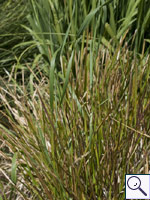 Broad-leaved Meadow-grass Poa chaixii |
Key for the identification of the known mines of British |
Note: Diptera larvae may live in a corridor mine, a corridor-blotch mine, or a blotch mine, but never in a case, a rolled or folded leaf, a tentiform mine or sandwiched between two more or less circular leaf sections in later instars. Pupation never in a cocoon. All mining Diptera larvae are leg-less maggots without a head capsule (see examples). They never have thoracic or abdominal legs. They do not have chewing mouthparts, although they do have a characteristic cephalo-pharyngeal skeleton (see examples), usually visible internally through the body wall. The larvae lie on their sides within the mine and use their pick-like mouthparts to feed on plant tissue. In some corridor miners frass may lie in two rows on alternate sides of the mine. In order to vacate the mine the fully grown larva cuts an exit slit, which is usually semi-circular (see Liriomyza huidobrensis video). The pupa is formed within the hardened last larval skin or puparium and as a result sheaths enclosing head appendages, wings and legs are not visible externally (see examples). See Key to non-Diptera. |
1# > Leaf-mine: Details unknown. |
|
Liriomyza orbona (Meigen, 1830) [Diptera: Agromyzidae]. |
1# > Leaf-miner: Details of mine unknown. |
|
Cerodontha fasciata (Strobl, 1880) [Diptera: Agromyzidae] |
| 1a > Leaf-mine: Larva and puparium in the leaf sheath; otherwise undescribed. |
Hosts in Britain unknow. On Poa elsewhere. Widespread in Britain and much of continental Europe. Also recorded in the Republic of Ireland |
Cerodontha atronitens (Hendel, 1920) [Diptera: Agromyzidae]. |
1b> Leaf-miner: Lower- or upper-surface corridor, possibly doubling one or two times, descends, sometimes as low as the leaf sheath. The gallery does not ocupy the entire width of the blade, runs along the midrib. Larva solitary. Frass as one big lump in the mine. Pupation internal. |
|
Cerodontha crassiseta (Strobl, 1900) [Diptera: Agromyzidae]. |
1c > Leaf-miner: Larva feeds mainly in the leaf sheaths. The short mines which may be formed in the leaf blade may be easily overlooked. Pupation internal (Spencer, 1976: 178). Mine begins as a narrow, usually upper-surface, occasionally lower-surface or interparenchymatous corridor in the blade, that descends towards the ligule, thence continues into the leaf sheath, generally on its inside. Usually only one mine per leaf. Puparium in a puparial chamber at the margin of the leaf sheath. Neither mine nor larva can be distinguished from that of C. fulvipes that, as far as is known, only feeds on Poa trivialis. |
|
Cerodontha denticornis (Panzer, 1806) [Diptera: Agromyzidae]. |
1d > Leaf-miner: The mine starts as a narrow, mostly upper-surface, sometimes lower-surface or interparenchymatous corridor that goes down to the ligula and from there descends into the leaf sheat, generally taking the inside. Usually only one mine per leaf. Pupation in the mine, in a puparial chamber at the margin of the leaf sheath. Neither mine nor larva can be separated from those of C. denticornis, that lives on a much wider range of hostplants (Nowakowski, 1973a). |
|
Cerodontha fulvipes (Meigen, 1830) [Diptera: Agromyzidae]. |
1e > Leaf-miner: Broad elongated mine; the form is dependent of the leaf form of the host plant. Frass green. Usually a number of larvae together in a mine. Pupation in the mine. |
|
Cerodontha incisa (Meigen, 1830) [Diptera: Agromyzidae]. |
1f > Leaf-miner: Broad lower surface mine which generally starts at the leaf apex.The mine is somewhat irregular in depth. Frass in irregular black-green, frequently melted grains, mostly along the edges of the mine. Larva solitary. Pupation generally internal. |
|
Cerodontha muscina (Meigen, 1830) [Diptera: Agromyzidae]. |
1g > Leaf-miner: Long, lower- or upper-surface blotch in the apical part of the leaf, occupying the entire width of the blade. Frass in a few lumps. Pupation internal. |
|
Cerodontha rohdendorfi Nowakowski, 1967 [Diptera: Agromyzidae]. |
1h > Leaf-miner: Upper-surface corridor, generally in the upper half of the blade, running up to the leaf tip, usually occupying more then half the width of the leaf. Frass in green stripes at either side of the corridor. Never more than one larva in a mine. Puparium within the mine, metallic black, not anchered with a string of silk. |
|
Cerodontha superciliosa (Zetterstedt, 1860) [Diptera: Agromyzidae]. |
1i > Leaf-miner: Larvae feed singly, forming an upper surface linear-blotch mine. Pupation either internal or external, with the puparium loosely glued to the leaf (Spencer, 1976: 91). Oviposition near the leaf margin, at some distance from the leaf tip. From there develops an upper-surface corridor-blotch. At first the mine ascends as a narrow corridor towards the leaf tip, then the direction turns and the mine, steadily widening, descends in the direction of the leaf base. Frass irregular, in rather coarse grains. Larva solitary. Pupation mostly outside the mine; in that case the puparium often sticks to the leaf. |
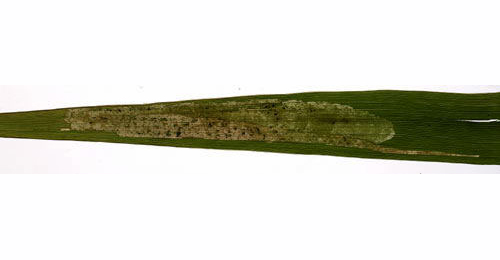 Mine of Agromyza albipennis on Phalaris arundinacea Image: © Willem Ellis (Bladmineerders van Europa) |
|
Agromyza albipennis Meigen, 1830 [Diptera: Agromyzidae]. |
1j > Leaf-miner: Long upper-surface corridor usually containing several larvae that graze shoulder to shoulder from the leaf tip downwards. Pupation outside the mine. Mines and larvae are indistinguishable from those of A. nigrella. |
|
Agromyza mobilis Meigen, 1830 [Diptera: Agromyzidae]. |
1k > Leaf-miner: Larval leaf-mine starts as a narrow channel running towards apex of leaf but later develops into a broad blotch running downwards. Frass largely diffused, giving the mine a characteristic greenish appearance. Pupation external (Spencer, 1976: 126). Corridor, usually several in one leaf, running from close to the leaf base up to near the tip, then reversing direction and widening, resulting in one communal mine in which the larvae descend in a common front. Frass somewhat deliquescent, mine therefore strikingly green. Pupation outside the mine. Neither mine nor larva distinguishable from those of mobilis. Puparium reddish brown |
|
Agromyza nigrella (Rondani, 1875) [Diptera: Agromyzidae]. |
1l > Leaf-miner: Mine greenish with only single larva, initially running towards apex of leaf before turning back down and developing into a broad blotch (Spencer, 1972b: 32, fig. 84; Spencer, 1976: 140, fig. 251). Deep, transparant corridor-blotch. The mine begins not far from the leaf apex, at first running upwards as a narrow corridor, then reverses and quickly widens to a blotch. A single larva per mine. Frass in isolated grains. Pupation inside or outside the mine. The mine is illustrated in the Encyclopedia of Life. Puparium reddish brown |
|
Agromyza rondensis Strobl, 1900 [Diptera: Agromyzidae]. |
1m > Leaf-miner: A lower surface mine. Pupation normally in the ground (Spencer, 1976: 202). Broad, usually lower-surface corridor in the blade, generally first rising, then descending. Mostly one larva in a mine, but sometimes several mines on a leaf may merge. Frass in grains that gradually become both larger and more widely spaced. Pupation outside the mine. |
|
Cerodontha flavocingulata (Strobl, 1909) [Diptera: Agromyzidae]. |
1n > Leaf-miner: A linear mine running towards the apex of the leaf and this can widen and become almost blotch-like. Pupation internal (Spencer, 1976: 194, 195 (fig. 340). Upper surface corridor, mostly in the lower half of the blade, running upwards, and never occuping more than half the width of the leaf. Larva solitary. Frass in green smears. Pupation inside the mine. |
|
Cerodontha lateralis (Macquart, 1835) [Diptera: Agromyzidae]. |
| 1o > Leaf-miner: Normally
several larvae feed together. Pupation in the mine (Spencer,
1976: 198).
Broad elongated blotch. Frass greenish. Larvae generally communal. Pupation within the mine. The black puaria are individially anchored within the mine with a silken thread attached at their rear end. Distinguishable from C. incisa only by means of the larva. |
|
Cerodontha pygmaea (Meigen, 1830) [Diptera: Agromyzidae]. |
1p > Leaf-miner: A substantial linear mine. Pupation internal; posterior spiracles projecting through the epidermis (Spencer, 1976: 449). Elongated, shallow, upper-surface or lower-surface blotch, not infrequently several in one leaf. Frass in strings or pearl chains. Pupation within the mine. |
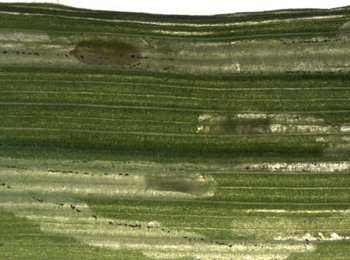 Mine of Chromatomyia milii on Holcus lanatus Image: © Willem Ellis (Bladmineerders van Europa) |
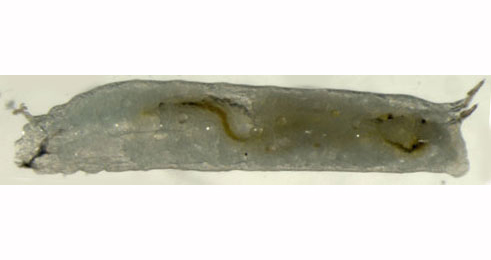 Chromatomyia milii larva, lateral Image: © Willem Ellis (Bladmineerders van Europa) |
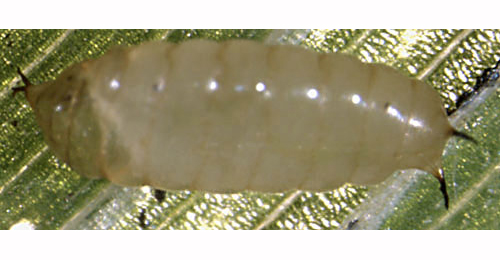 Chromatomyia milii larva, dorsal Image: © Willem Ellis (Bladmineerders van Europa) |
|
Chromatomyia milii (Kaltenbach, 1864) [Diptera: Agromyzidae]. |
1q > Leaf-miner: Long, narrow, whitish mine. Pupation internal (Spencer, 1976: 453); anterior spiracles projecting through the epidermis. Whitish, upper-surface, rather narrow corridor with comparatively large frass grains that are laying further apart than their diameter. Pupation within the mine. The anterior spiracles of the orange-brown puparium penetrate the epidermis. |
 Chromatomyia nigra larva, lateral Image: © Willem Ellis (Bladmineerders van Europa) |
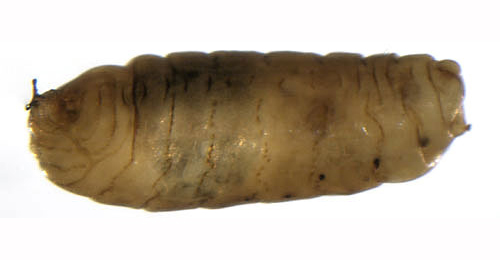 Chromatomyia nigra pupa, lateral Image: © Willem Ellis (Bladmineerders van Europa) |
|
Chromatomyia nigra (Meigen, 1830) [Diptera: Agromyzidae]. |
1r > Leaf-miner: Narrow whitish mine, with frass in distinct black lumps. Pupation internal (Spencer, 1976: 422). Whitish, upper-surface, descending corridor, about halfway up the blade. Frass in distinct black grains that are lying further apart than their diameter. Pupation in the mine. |
|
Chromatomyia fuscula (Zetterstedt, 1838) [Diptera: Agromyzidae]. |
1s > Leaf-miner: A narrow whitish linear mine, running down the leaf from the apex, with frass in two rows of separate grains. Pupation external (Spencer, 1976: 246). Narrow corridor from start to end, whitish, uppper- or lower-surface, genarally running downwards. Mine often along the leaf margin. Frass in distict grains of regular size, alternating along the sides of the corridor. Pupation outside the mine. |
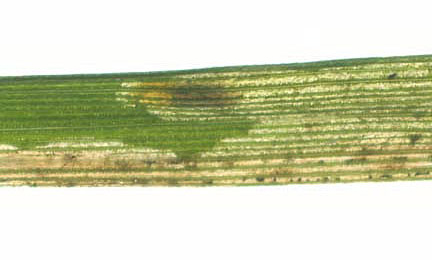 Mine of Liriomyza flaveola on Festuca gigantea Image: © Willis Ellis (Bladmineerders van Europa) |
|
Liriomyza flaveola (Fallén, 1823) [Diptera: Agromyzidae]. |
1t > Leaf-miner: Upper surface corridor mine. The mine starts at the leaf apex. Frass in clumps or closely packed grains. |
|
? Liriomyza graminivora Hering, 1949 [Diptera: Agromyzidae]. |
1u > Leaf-miner: A short narrow mine, generally near apex of leaf. Larva with each segment bearing a row of characteristic papilli which are retained in the puparium (Spencer, 1976: 328). Pupation internal. Transparent, short and narrow mine not far from the leaf tip. Frass in two rows of grains. Pupation outside the mine. |
|
Pseudonapomyza atra (Meigen, 1830) [Diptera: Agromyzidae]. |
1v > Leaf-miner: Irregular mine, locally shallow, elsewhere much deeper, giving it a mottled appearance. In broadleaved plants the mine often begins as a blotch with stellate extensions, but sometimes as a very fine, shallow corridor. In grasses the mine often begins in the leaf sheath. The frass is very fine-grained, initially scattered, later in aggregates. The egg is deposited on the plant surface, and the empty egg shell remains visible. But the larvae are able to leave their mine and restart elsewhere, thus mines without an egg shell can be found as well. The larva also leaves the mine before pupation. Pupation takes place in a newly made, small, blotch mine without frass; this mine may be made in another plant (species). |
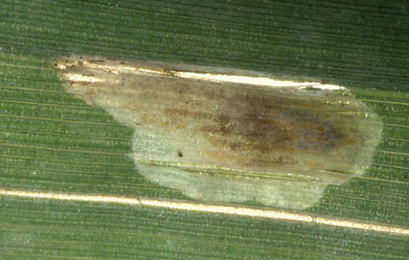 Mine of Hydrellia griseola on Glyceria fluitans Image: © Willem Ellis (Bladmineerders van Europa) |
|
Hydrellia griseola (Fallén, 1813) [Diptera: Ephydridae]. |
|
Key for the identification of the known mines of British |
|
Note: The larvae of mining Coleoptera, Hymenoptera and Lepidoptera may live in a corridor mine, a corridor-blotch mine, a blotch mine, a case, a rolled or folded leaf, a tentiform mine or sandwiched between two more or less circular leaf sections in later instars. Larva may pupate in a silk cocoon. The larva may have six legs (although they may be reduced or absent), a head capsule and chewing mouthparts with opposable mandibles (see video of a gracillarid larva feeding). Larvae of Hymenoptera and Lepidoptera usually also have abdominal legs (see examples). Frass, if present, never in two rows. Unless feeding externally from within a case the larva usually vacates the mine by chewing an exit hole. Pupa with visible head appendages, wings and legs which lie in sheaths (see examples). |
|
1a > Leaf/Stem miner: The larvae mine the stems of various coarse grasses (UKMoths; Plant
in Pitkin & Plant, 2005). The larva mines just a few days in the leaf, then continues as a stem borer on the lower part of the stem. They regularly move to a new stem. The central leaves of the infested plants wither and die. |
|
|
|
Ochsenheimeria taurella (Denis & Schiffermüller, 1775) [Lepidoptera: Ypsolophidae]. |
|
1b > Leaf-miner and case-bearer: The larva lives outside the mine, protected by a case, and feeds on the underlying plant tissues via a hole cut in the epidermis. From that point it eats away as much leaf tissue as it can reach without fully entering the mine. Mine does not contain frass (Coleophora species) |
|
1c > Leaf-miner, but not a case-bearer: The larva lives mainly inside the mine. Mine usually contains frass. In later instars the larva may live sandwiched between two more or less circular sections cut from the leaf. |
|
2a > Leaf-miner and case-bearer: The young larva eats the receptacle out of a floret of Acinos arvensis, and uses the calyce as its first case. Even before the onset of winter it switches to grasses. The larva then lives in an ochraceous, bivalved, tubular leaf case of c. 9 mm, with a mouth angle of c. 25°. The case is illustrated in British Leafminers. |
|
|
|
Coleophora tricolor Walsingham, 1899 [Lepidoptera: Coleophoridae]. |
|
2b > Seed-feeder, leaf-miner and case-bearer: Initially it feeds on the seeds of thyme and then uses the seedhead as a case. It overwinters in this case and starts feeding again in March on grass spp. It then makes a case from the mined blade of grass. The larva initially feeds on the seeds of thyme, feeding within a floret and using this as its case. After overwintering, it changes foodplants to grass, and eventually forms an elongated case from two grass blade portions sewn together. The larva begins its life by eating out the ripe fruit of a thyme floret. The emptied and dried calyx functions as its first case, in which it hibernates. After hibernation the larva switches to grasses, initially in its original thyme case. Later a new case is made out of a mined grass leaf. This final case is about 11 mm long, two-valved, straw-coloured, has a mouth angle of 25°, and bears a striking resemblance to a grass spikelet. |
|
|
|
Coleophora lixella Zeller, 1849 [Lepidoptera: Coleophoridae] |
|
3# >Leaf-miner: Narrow, flat gallery, descending from the tip of the leaf. |
|
|
|
Elachista collitella (Duponchel, 1843) [Lepidoptera: Elachistidae]. |
|
3# > Leaf-miner: Details unknown. |
|
|
|
Elachista consortella Stainton, 1851 [Lepidoptera: Elachistidae]. |
|
3a > Leaf-miner: Tufted hair-grass and blue moor-grass are the main foodplants, the larvae forming gallery mines. Gradually widening corridor, running either upwards or down. All frass is deposited in the earliest part of the mine. Often 2-3 larvae in a mine; in grasses with broad leaves sometimes more than one mine in a leaf. |
|
|
|
Elachista adscitella Stainton, 1851 [Lepidoptera: Elachistidae]. |
|
3b > Leaf-miner: Corridor, 15 cm in the end, descending from the leaf tip. The mine is whtish and shallow at first, then becomes deeper, yellowish white, and more transparant. Pupation external; pupa, not in a cocoon, attached to the leaf. |
|
|
|
Elachista albidella Nylander, 1848 [Lepidoptera: Elachistidae]. |
|
3c > Leaf-miner: The larva mines from the grass tip downwards and the mine occupies half or the whole of the leaf blade width. A whitish blotch is formed with characteristic narrow streaks of frass. Full depth blotch, slightly inflated, descending from the leaf tip, occupying half or the entire width of the blade. The larva may move and make a new mine elsewhere. In the latter case the mines are fairly short; otherwise an entire blade may be mined out. Frass in a some narrow greyish brown streaks. Pupation outside the mine. |
|
|
|
Elachista albifrontella (Hübner, 1817) [Lepidoptera: Elachistidae]. |
|
3d > Leaf-miner: Corridor widening while descending from the tip of the leaf. The mine is unusual because the sides are very irregularly scalloped out. Moreover, the mine is not evenly transparent, but rather yellowish green and motly, because the larva leaves patches of parenchyma uneaten, and does not feed full depth. Frass in a few irregular, interrupted length lines. Often 2-3 larvae in a mine. The larvae hibernate in the centre of the mine; after winter they leave their mine and pupate. |
|
|
|
Elachista apicipunctella Stainton, 1849 [Lepidoptera: Elachistidae]. |
|
3e > Leaf-miner: In autumn the larva makes a narrow corridor a few cm in length, in which it hibernates. In March it moves to a new leaf. Here a transparent, full depth mine is made that descends from the leaf tip, and occupies the entire width of the blade. Most frass is concentrated in the oldest, highest, part of the mine. The larva may leave its mine and restart elsewhere. Pupation outside the mine |
|
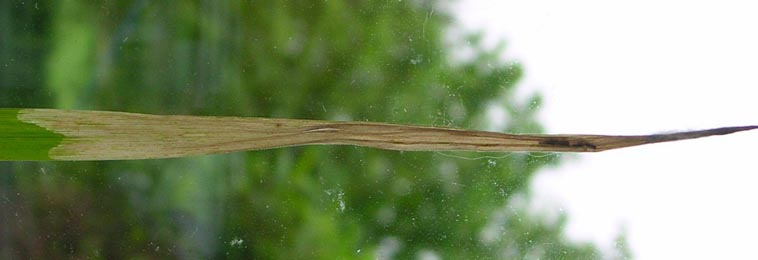 Mine of Elachista argentella on Dactylis glomerata Image: © Ben Smart (British leafminers) |
|
|
|
| Elachista argentella (Clerck, 1759) [Lepidoptera: Elachistidae]. | |
3f > Leaf-miner: Blotch in the leaf tip; the upper side is practically flat, the lower side can turn somewhat to purple. The larva may mine 2-3 leaves. |
|
|
|
Elachista bedellella (Sircom, 1848) [Lepidoptera: Elachistidae]. |
|
3g > Leaf-miner: Flat, whitish. Pupation outside the mine. |
|
|
|
Elachista canapennella (Hübner, 1813) [Lepidoptera: Elachistidae]. |
|
3h > Leaf-miner: The larvae mine the blades of various grasses, including meadow-grass and cock's-foot. Long, flat, whitish, relatively broad corridor descending from the leaf tip. Frass irregularly scattered. The larva may make several mines during its lifetime. Pupation outside the mine. |
|
|
|
Elachista freyerella (Hübner, 1825) [Lepidoptera: Elachistidae]. |
|
3i > Leaf-miner: In spring a short corridor is made that is almost stuffed with frass. After hibernation this mine is vacated, and the larva then makes a number of elongated blotches, all descending from the leaf tip. These latter mines are whitish, with irregularly scattered frass. |
|
|
|
Elachista humilis Zeller, 1850 [Lepidoptera: Elachistidae]. |
|
3j > Leaf-miner: Long, narrow, white corridor, descending from close to the leaf tip to the leaf base or even stem. Frass in an inconspicuous grey line. From the stem the larva may enter a new leaf (Steuer, 1987a; Bland, 1996a). |
|
|
|
Elachista luticomella Zeller, 1839 [Lepidoptera: Coleophoridae]. |
|
3k > Leaf-miner: Larva makes a large whitish blotch and mines the leaf downwards. The frass tends to be deposited in the upper part of the mine. Oviposition usually not far from the leaf tip. From there descends an irregular blotch mine. Hering (1957a) describes the mine as flat and quite shallow, giving it a greenish, rather than whitish appearance. Frass initially in the oldest, upper part of the mine, later in strings. The larva can leave its mine and restart elsewhere. Normally only one larva per mine, but sometimes two or even three mines in a leaf. Pupation outside the mine. |
|
|
|
Elachista maculicerusella (Bruand, 1859) [Lepidoptera: Elachistidae]. |
|
3l > Leaf-miner: Initially a narrow brownish mine with blackish frass at its base, then moves to another leaf, forming a broader mine. Both mines can pucker the blade. |
|
|
|
Elachista obliquella Stainton, 1858 [Lepidoptera: Elachistidae]. |
|
3m > Leaf-miner: The mine begins near the leaf tip and descends towards the base. The mine occupies the entire width of the blade. Frass initially scattered, later in an irregular central line. Fully developed mine c. 8 cm long. Probably the larva is capable of leaving its mine and restarting in another leaf. Pupation external. |
|
|
|
Elachista pomerana Frey, 1870 [Lepidoptera: Elachistidae]. |
|
3n > Leaf-miner: Mines downwards from leaf tip to stem. Makes a long narrow yellowish mine. May be up to four larvae in one leaf. Long narrow yellowish corridor, descending from the leaf tip to its base; at times 3-4 larvae in a leaf. Often several larvae in a communal mine. Pupation outside the mine. |
|
|
|
Elachista stabilella Stainton, 1858 [Lepidoptera: Elachistidae]. |
|
3o > Leaf-miner: The larva creates a long narrow mine in the blade. Mine fairly translucent. It starts as a narrow corridor, running towards the leaf tip, but this almost invariably is overrun be a later, broad, descending corridor. The centre of the mine contains a vertical tube made of loose silk, in which the larva can quickly move up or down, and in which also most frass gets trapped. The sides of the mine are smooth (contrary to E. gangabella). Mines are difficult to find, because the leaves are wilting when larvae are present. |
|
|
|
Elachista subalbidella Schläger, 1847 [Lepidoptera: Elachistidae]. |
|
3p > Leaf-miner and Stem-borer: The first instar lave mines in a leaf; after that it lives as a stem borer. |
|
|
|
Ochsenheimeria vacculella Fischer von Röslerstamm, 1842 [Lepidoptera: Ypsolophidae]. |
| Last updated 06-Jul-2019 Brian Pitkin | ||
